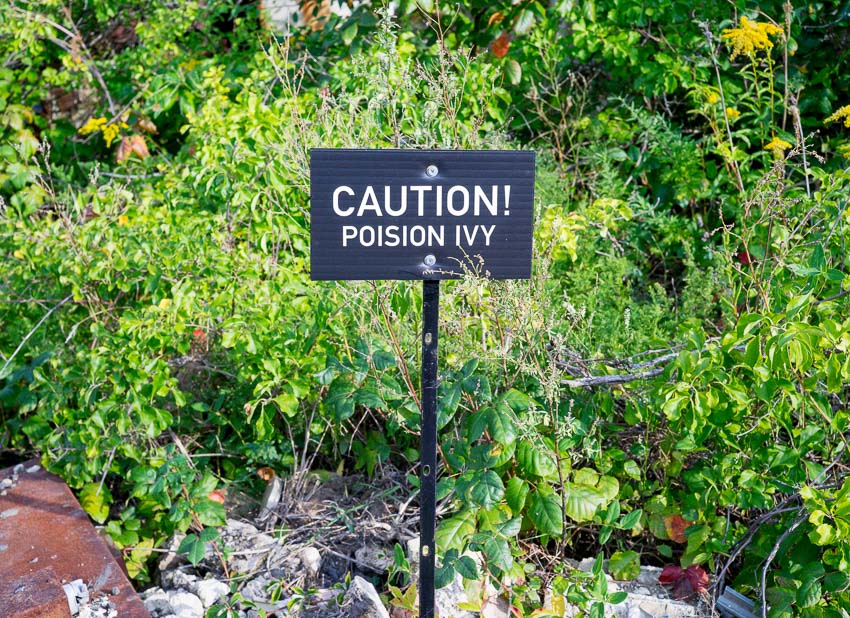Weeds in your yard and garden are a nuisance, but even worse, they can be dangerous. Use our guide to poisonous weeds to find out everything you need to know, including their potential health risks and effective strategies for removal.
Understanding Poisonous Weeds
Some poisonous weeds are fatal to humans and animals. And while most adults know not to consume poisonous plants, they present a significant danger to small children, pets, and livestock. Explore the most common types of poisonous weeds and their various health risks and dangers.
Common Types of Poisonous Weeds
This comprehensive guide to poisonous weeds focuses on the top five toxic plants in the United States. It’s important to know about common types of poisonous weeds that could be growing in your backyard.
Here is a list of the most poisonous weeds in North America:
- Poison ivy
- Giant hogweed
- Poison oak
- Jimsonweed
- Water hemlock
- Poison sumac
- Daffodils
- Castor bean
- Oleander
- Climbing nightshade
- Spurge
- Ragwort
- Horsetail
- White snakeroot
- Dwarf larkspur
Many more poisonous grow in fields, forests, gardens, and yards throughout the United States. Only eat plants with proper identification, and use caution when letting livestock out to pasture.
Potential Health Risks and Dangers
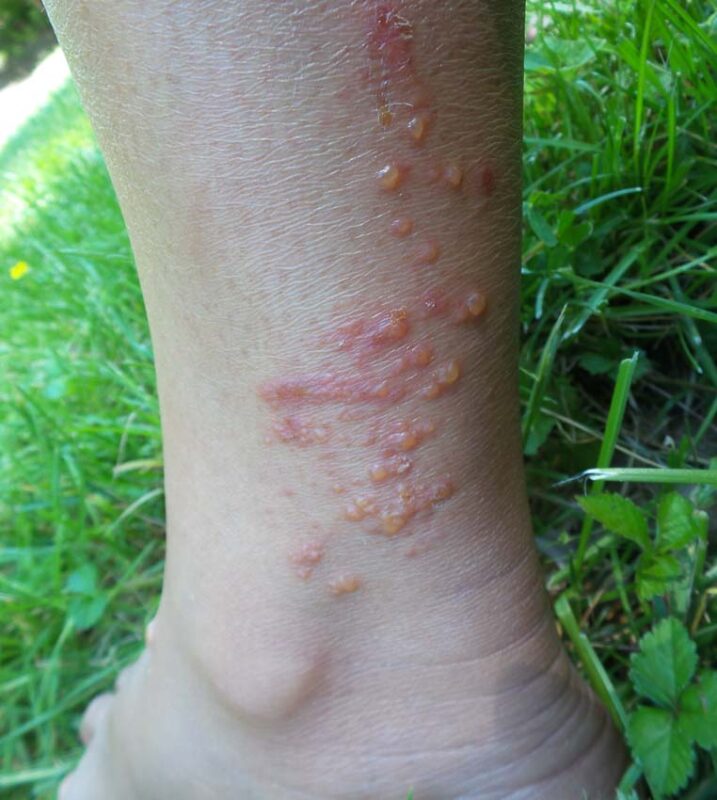
As you’ll see in our guide to poisonous weeds, many plants, like poison ivy, cause skin rashes and irritation when you touch or brush against them. Symptoms of irritation include redness, itching, and burning sensations, and people with sensitive skin can suffer more adverse effects.
Here is a list of possible symptoms of poisoning caused by toxic plants:
- Skin irritation and rashes
- Respiratory irritation or failure
- Organ damage, including kidney and liver failure
- Digestive upset, nausea, vomiting, and diarrhea
- Neurological damage and seizures
- Blood pressure problems
- Death
Internal poisoning is most common in young children, who are also more susceptible to health risks.
Children are usually attracted to poisonous plants with bright berries or interesting flowers, but they may put other parts of poisonous plants in their mouths. It’s critical to teach children at a young age not to eat plants without permission.
Pets and livestock are also vulnerable to poisonous weeds. Dogs and cats graze on grass and other weeds in your yard and may accidentally consume poisonous plants.
Cases of livestock poisoning usually occur when toxic plants spread to pastures and fields. Sometimes, there are enough poisonous weed chemicals in baled hay to cause the death of livestock.
Identifying Common Poisonous Weeds
Also in this guide to poisonous weeds, we’ll identify the most common offenders. These include poison ivy, giant hogweed, poison oak, jimsonweed, and water hemlock. Study their key identifying features and learn the potential health risks and symptoms associated with consuming or touching these toxic plants.
Poisonous Weed #1: Poison Ivy (Toxicodendron radicans)
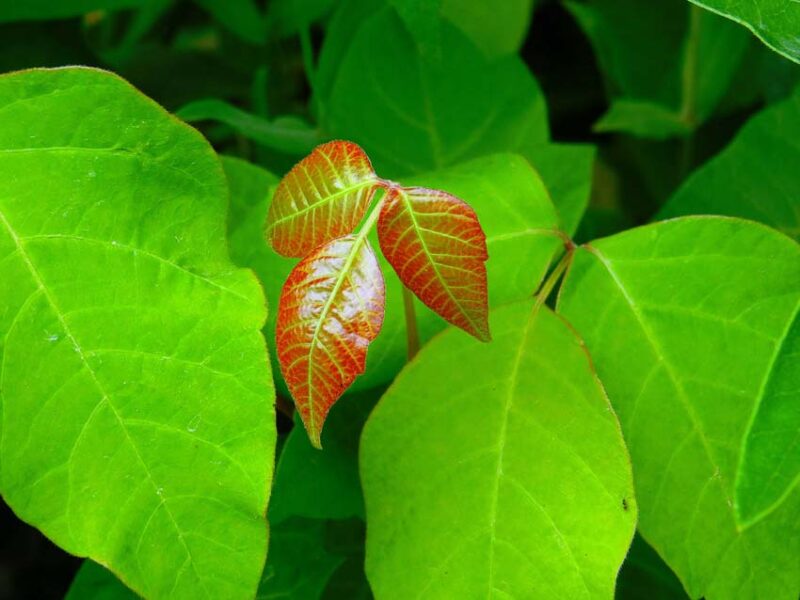
Key Identifying Features
Number one in our guide to poisonous weeds is poison ivy. It can grow as a small plant, shrub, or climbing vine, but its clusters of three glossy leaves easily identify it. The leaves are tear-shaped or egg-shaped, and the plant has clusters of green flowers in late spring and early summer, which produce small white berries in the fall.
Poison ivy grows in many habitats and in every state except Alaska and Hawaii.
Potential Health Risks and Symptoms
The oil in poison ivy that most people are allergic to is called urushiol, and it also occurs in poison sumac and poison oak. Contact with poison ivy may cause mild to severe allergic reactions in some people, and the oil is also released when plants are damaged or burned.
In contact dermatitis caused by urushiol, symptoms include itchy and inflamed skin, blisters, swelling, and rash. Some people are extremely allergic, and poison ivy can cause life-threatening anaphylaxis requiring immediate medical attention.
Swelling in the face, difficulty breathing, dizziness, and loss of consciousness are all signs of anaphylactic reactions.
Wash body parts exposed to poison ivy with cool water to remove the urushiol. You can treat rashes with calamine lotion, antihistamines, hydrocortisone, and cold showers. Contact a physician if there is difficulty breathing or other signs of anaphylaxis.
Poisonous Weed #2: Giant Hogweed (Heracleum mantegazzianum)
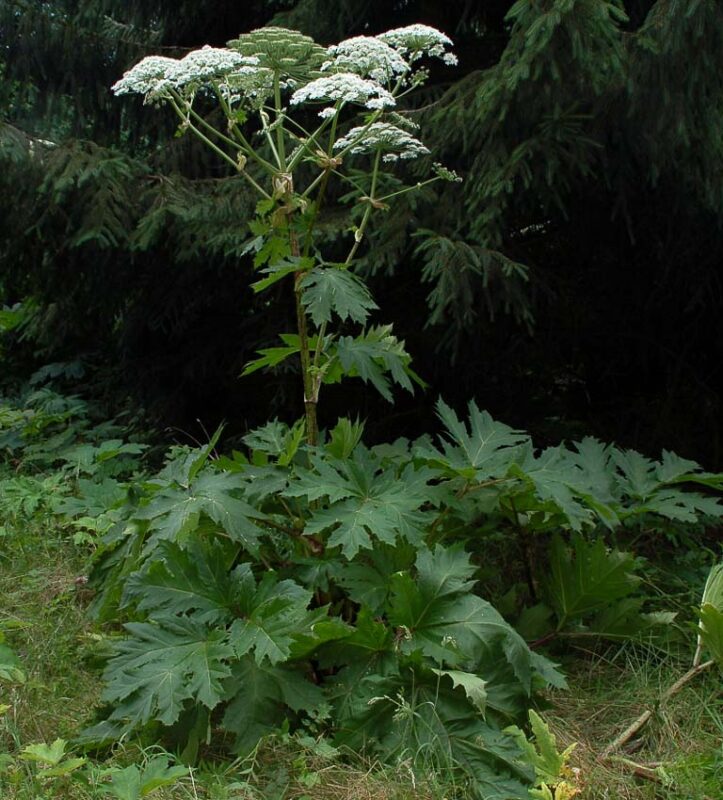
Key Identifying Features
Giant hogweed is a carrot family member and has characteristic umbrella-shaped flowers called umbels. It commonly grows up to 10 to 15 feet tall, with stems two to four inches in diameter. The hollow stems have raised purplish blotches, and the plants are up to three feet wide.
Giant hogweed prefers cool, moist environments and grows along rivers, ditches, roadsides, and railroad tracks.
Potential Health Risks and Symptoms
The poisonous part of this weed is the sap, as we’ll explain here in our guide. It contains phototoxic chemicals that are activated by UV light. The sap causes redness, blisters, and burns, and it usually affects the arms, hands, face, legs, and eyes.
Burns develop about 15 minutes after exposure, and the scars of severe burns usually persist for a few months. In some cases, scarring takes years to heal, and long-term sensitivity to light is in affected areas.
Wash with soap and cold water as quickly as possible after exposure. If it gets in the eyes, rinse with water and wear sunglasses. Consult a doctor if you have other adverse reactions.
Poisonous Weed #3: Poison Oak (Toxicodendron diversilobum)
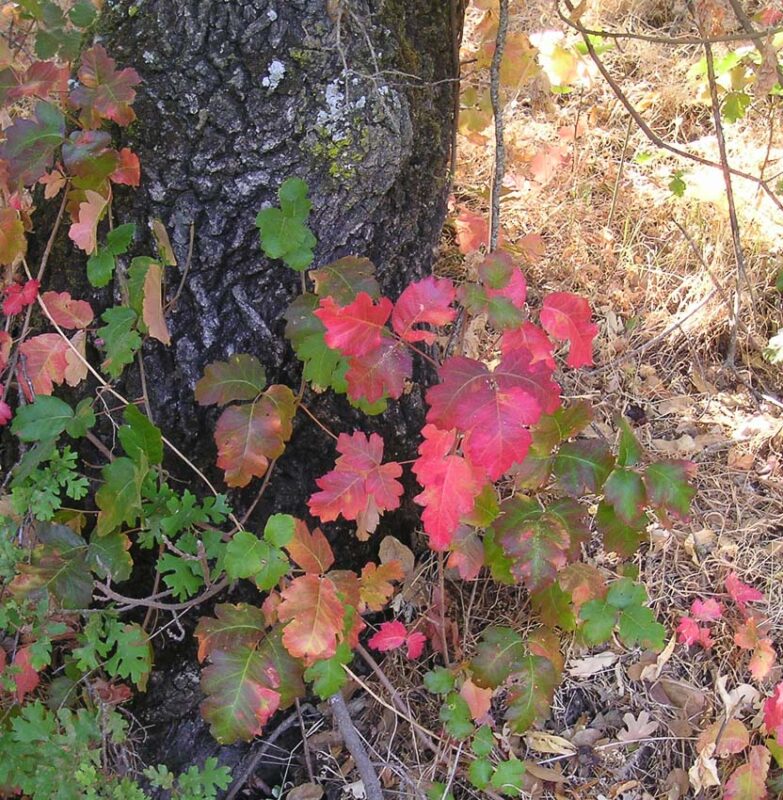
Key Identifying Features
Like poison ivy, poison oak varies widely in growth habits. It can grow as a shrub or vine, individually or in thick hedges.
The leaves, which appear in groups of three, are similar to poison ivy, but they are more rounded. They are up to 4 inches long and vary in color throughout the seasons, making identification challenging.
Because poison oak is deciduous, it’s even harder to identify in the winter.
Poison oak grows in western North America’s forests, meadows, and grasslands.
Potential Health Risks and Symptoms
Like poison ivy, poison oak exposure causes skin irritation due to allergic reactions to urushiol. About 20% to 25% of people are not allergic to urushiol, but most get more sensitive to it after repeated exposure.
Urushiol becomes more volatile when burned, and exposure to poison oak caused by smoke inhalation is extremely dangerous. Symptoms of smoke inhalation include breathing difficulties, fevers, and rashes on the lips and inside the mouth.
Apply topical cortisone creams, calamine lotion, and wet compresses to rashes, and seek medical attention if you have difficulty breathing.
Poisonous Weed #4: Jimsonweed (Datura stramonium)
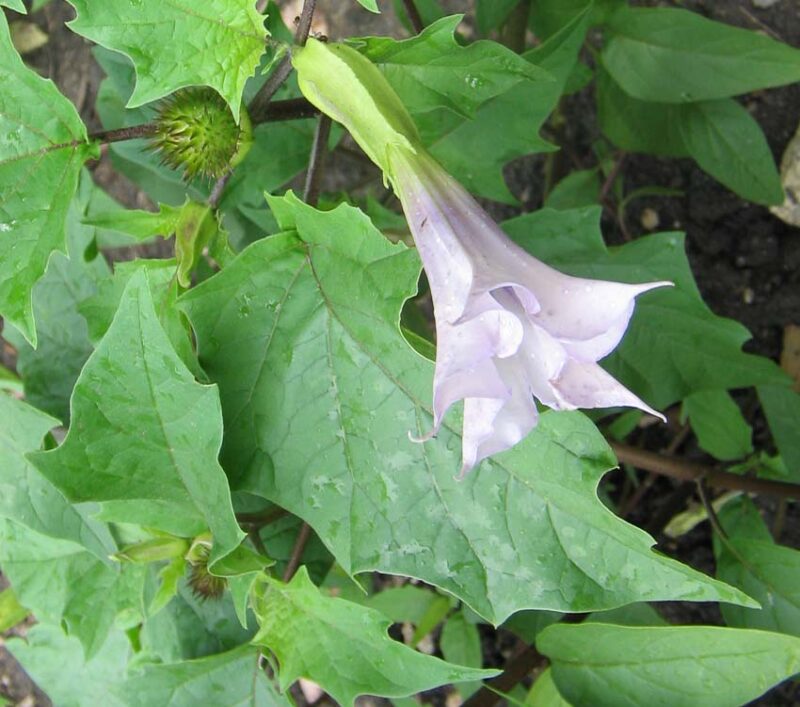
Key Identifying Features
Number four in our guide to poisonous weeds is Jimsonweed. This plant grows three to five feet tall, with toothed green leaves and tinged reddish-purple stems. The blossoms, which are four-inch-long white funnel-shaped flowers, are the most striking part of the plant.
The seed pods are also intriguing. They are about the size of a ping pong ball and covered with spiny protrusions, giving rise to the common name thorn apple.
Potential Health Risks and Symptoms
Jimsonweed is also known as devil’s weed, and all parts of the plant are extremely toxic.
Many people have died trying to use the plant for its hallucinogenic properties. It contains alkaloids that are toxic in high doses, causing gastrointestinal and nervous system symptoms when ingested.
All parts of jimsonweed are toxic to humans and animals, but there isn’t any danger in touching the plant. However, you should wear gloves when pulling jimsonweed and wash your hands after coming in contact with it, especially if you have sensitive skin or open cuts.
Most livestock won’t eat jimsonweed, except for goats, and it can be fatal in small doses, so they must be protected from it.
You can use physostigmine to treat jimsonweed poisoning. Other than accidental poisoning, cases of poisoning are due to youth experimenting with the hallucinogenic properties, so it’s important to counsel teens about the dangers of jimsonweed.
Poisonous Weed #5: Water Hemlock (Cicuta spp.)
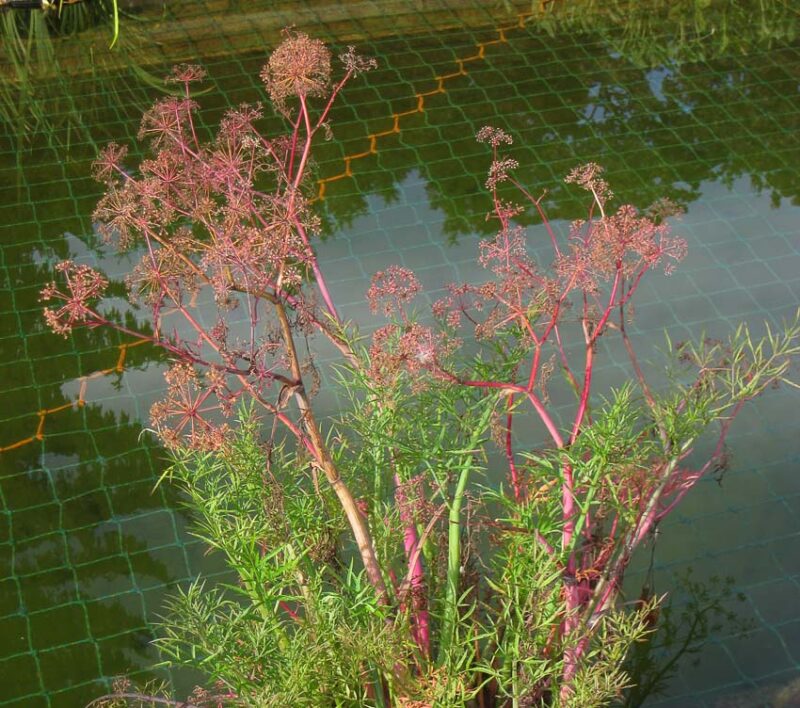
Key Identifying Features
Like giant hogweed, water hemlock is another toxic plant in the carrot family. It has the same characteristic umbel flower heads and fern-like feathery leaves that are similar in appearance to Queen Anne’s lace, which is another close relative. Water hemlock grows up to seven feet tall, and the best way to distinguish it from its close relatives is the stems, which are smooth with purplish blotches.
Water hemlock has a wide range, but it’s not common. It grows in wet soils found in ponds, ditches, and stream banks.
Potential Health Risks and Symptoms
Water hemlock is widely considered the most poisonous plant in the United States, and medical attention is required if even a small amount is ingested. Ingesting water hemlock can be fatal in less than 15 minutes. The toxic compound cicutoxin is found in the roots and has a strong carrot-like smell.
The first signs of water hemlock poisoning are drooling, nausea, dizziness, vomiting, and lethargy. Seizures and convulsions follow uncontrolled bowel movements, and without immediate medical attention, death.
Natural Remedies for Poisonous Weed Control
If you prefer to avoid harsh chemicals and weed killers, there are natural remedies for poisonous weed control. Learn more about organic methods for removing weeds.
Organic Herbicides and Weed Control Solutions
The best options for controlling poisonous plants naturally include organic herbicides and mulches. A thick mulch will stop weed growth and kill plants like poison ivy. Some types of weeds can be mowed or cut to control their growth and spread.
Manual Weed Removal and Prevention
Goats are one way to keep noxious weeds knocked back, but don’t let them eat jimsonweed because it can be fatal to them. However, they are an excellent way to control large poison ivy patches naturally.
Many weeds, including giant hogweed, are easiest to control by cutting them back when they are small with a sharp shovel. Weeds can also be pulled by hand.
Protective Clothing for Handling Poisonous Weeds Safely
If you control weeds manually, protect your face, hands, arms, and legs, especially with weeds like poison ivy and giant hogweed. Wear long sleeves, pants, work boots, and work gloves.
Using warm water, launder clothing that has been exposed to poisonous weeds separately. Also, be sure to wash tools and equipment that have come in contact with poisonous weeds.
Proper Removal and Disposal Techniques
Dried poisonous weeds are still toxic. You should carefully dispose of them to prevent contact and exposure. The best way to properly remove poisonous weeds is by putting them in a garbage bag and double or triple bagging them.
Some people prefer to compost poisonous plants, which you can safely do if you give them several months to completely decompose before handling the compost. It’s always a good idea to wear gloves when handling compost.
Poisonous Weeds FAQs
Are all colorful plants and flowers poisonous?
Many colorful plants and flowers are not poisonous. However, most plant-related internal poisonings are caused by young children eating or chewing on interesting flowers, seed pods, and berries, so it’s important to teach them not to eat anything without permission.
Can I safely touch or handle poisonous weeds with gloves?
You should protect your skin from poisonous weeds by wearing gloves, long pants, and long shirts. This is especially true with weeds like poison ivy and poison oak, which contain an oil that causes rashes and blisters.
How can I protect my pets from poisonous weeds?
If poisonous weeds grow where you live, you can either fence off the areas where they grow or build a fence to contain your pet. Design your landscape with your pet in mind using dog-friendly landscaping that protects them from dangers like toxic plants.
Can poisonous weeds contaminate fruits and vegetables in my garden?
Some vegetables can absorb toxins from the soil, but toxic plants don’t make other plants poisonous. You can put poisonous plants in your compost because the toxins are broken down during decomposition. Always wear gloves when handling compost, just in case.
What should I do if I suspect exposure to a poisonous weed?
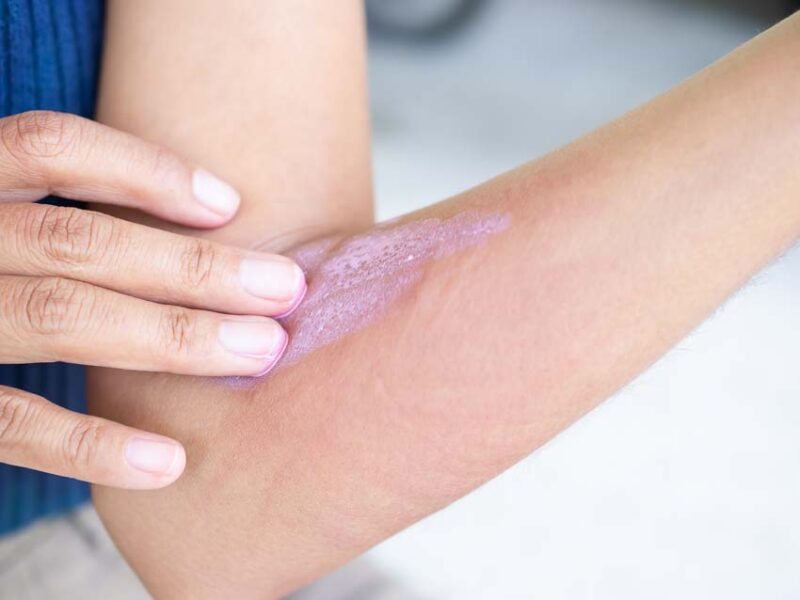
If you suspect exposure to a poisonous weed, rinse the exposed area with soap and cold water or use alcohol wipes. Treat the rash with calamine lotion and antihistamines . Always call 911 if you have difficulties breathing after exposure to poisonous plants.

